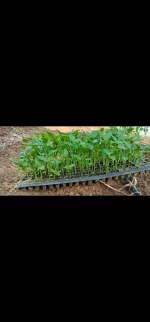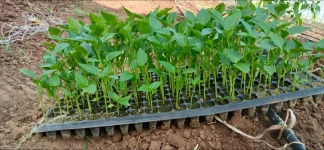kenthefarmer
Lister
Growing capsicum in a greenhouse provides an ideal environment for long-term harvesting and higher yields. Passarela (red) and Ilanga (yellow) varieties are especially profitable, offering vibrant colors and excellent market demand. Here’s a step-by-step guide:
1. Seedlings Purchase and Land Preparation
I buy seedlings at Ksh 10 each from trusted suppliers. Ensuring they are disease-free and healthy for the best results.
Land Preparation:
Plow the soil thoroughly and mix it with well-decomposed manure.
Maintain a pH of 5.5-6.8 for optimal growth. Adjust the pH using lime (if acidic) or sulfur (if alkaline).
Prepare raised beds for better drainage and aeration.
2. Transplanting
Transplant seedlings when they have 4-6 true leaves, typically 4-6 weeks old.
Space the plants 45 cm apart within rows and 60 cm between rows for proper air circulation and sunlight.
Water the plants immediately after transplanting to minimize transplant shock.
3. Trellising
Install stakes or trellises shortly after transplanting.
Use soft ties to support the plants and prevent fruits from touching the soil.
Trellising promotes airflow, reduces disease risk, and supports better fruit quality.
4. Feeding and Fertilizer Application
Proper nutrition is crucial for achieving high yields and healthy fruits.
Fertilizer Schedule:
At Transplanting: Apply phosphorus fertilizer like Dap for strong root growth.
Vegetative Stage (Weeks 1-6): Apply nitrogen-rich fertilizers like CAN or Yara Nitrabol to encourage leafy growth.
Flowering Stage: Use potassium-rich fertilizers such as MOP or Winner for better flowering and fruiting.
Fruiting Stage: Apply balanced fertilizers (e.g., NPK 17:17:17) and supplement with calcium nitrate to prevent blossom end rot.
Frequency: Top-dress every 3-4 weeks and complement with foliar sprays rich in micronutrients (boron, magnesium) for healthier fruits.
5. Pest and Disease Management
Major Pests:
1. Aphids:
Symptoms: Curled leaves, stunted growth, and sticky honeydew.
Control: Use insecticides like Imidacloprid or neem oil. Introduce beneficial insects like ladybugs.
2. Thrips:
Symptoms: Silver streaks on leaves and deformed fruits.
Control: Use Spinosad or Blue sticky traps to monitor and reduce thrip populations.
3. Whiteflies:
Symptoms: Yellowing leaves and sooty mold on leaves.
Control: Apply insecticidal soap or yellow sticky traps. Rotate insecticides to avoid resistance.
4. Cutworms:
Symptoms: Severed seedlings at the base.
Control: Apply soil insecticides and maintain clean fields to reduce hiding spots.
Major Diseases:
1. Blossom End Rot:
Cause: Calcium deficiency or inconsistent watering.
Control: Apply calcium nitrate and maintain consistent soil moisture.
2. Powdery Mildew:
Symptoms: White powdery patches on leaves.
Control: Use sulfur-based fungicides or potassium bicarbonate sprays. Ensure proper ventilation in the greenhouse.
3. Bacterial Wilt:
Symptoms: Sudden wilting of plants and brown vascular tissues.
Control: Use resistant varieties, practice crop rotation, and sterilize soil before planting.
4. Damping Off (in seedlings):
Symptoms: Seedling stems become thin and collapse.
Control: Avoid overwatering and improve soil drainage. Treat with copper-based fungicides.
6. Watering and Irrigation
Capsicum requires consistent moisture for optimal growth. Drip irrigation is ideal as it delivers water directly to the root zone while minimizing wastage.
Avoid overwatering to prevent root rot and other waterborne diseases.
7. Harvesting
Capsicum typically reaches maturity 70-80 days after transplanting, but you can continue harvesting for several months in a greenhouse environment.
Yield: A greenhouse measuring 8 meters by 31 meters can produce over 200 kg of capsicum per harvest, with prices exceeding Ksh 120 per kg.
By managing pests and diseases effectively and maintaining proper feeding schedules, you can achieve a long harvesting season with high-quality yields.
~village investor


